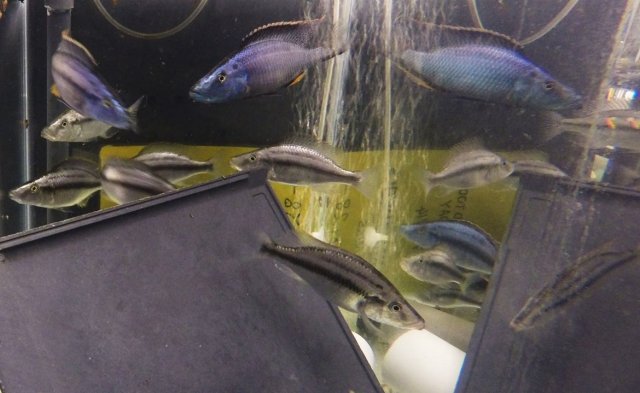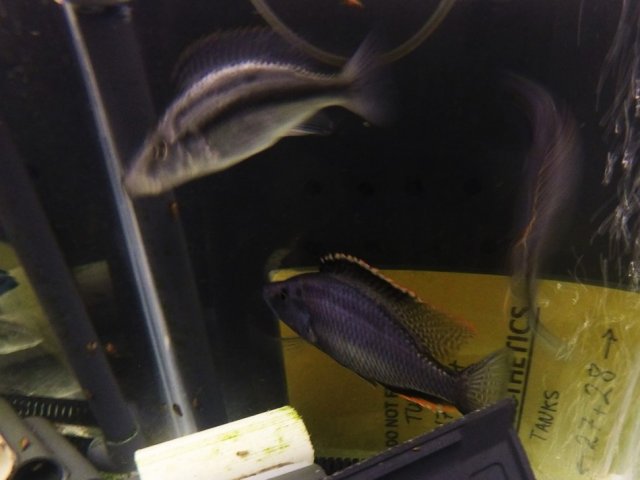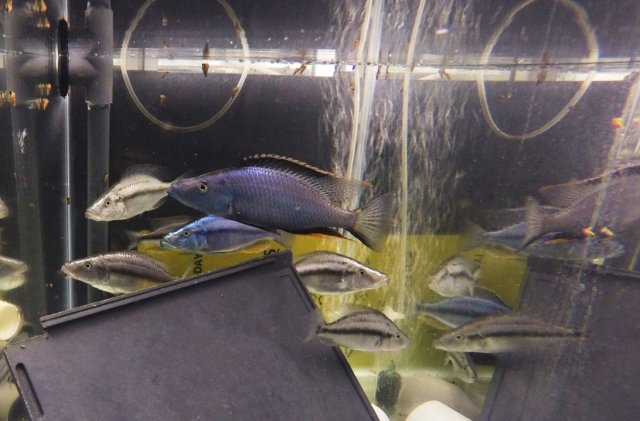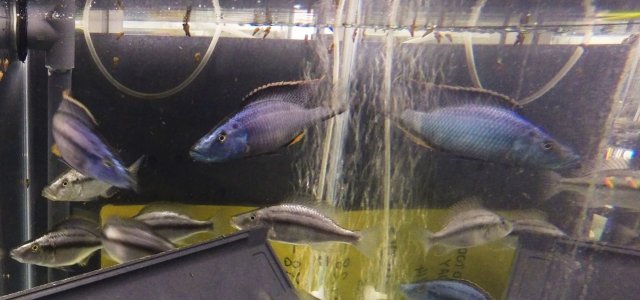I don't know if anyone is interested but I have found some really cool stuff with this research so far. I'm really excited about it and needed to share it with more people, discussing it at institute pub nights just really hasn't been cutting it for me lately (I'm also avoiding doing my work and pushing off my cravings for nachos and drinks).
Here's some general info:
Species: Malawi Eye Biter (Dimidiochromis compressiceps) (previous Haplochromis compressiceps)
SIMPLIFIED METHODS:
Spawning and Raising
Size
The results haven't been published yet but we are confident that after adding in another family or two we will have a really good publishable paper. Currently, we could publish it now, but we'd like to get some of my stats that are borderline over the line and into significant which would really increase the amount I can conclude from my research.
The project I am working on at the moment is looking at maternal effects on shoal cohesion of juveniles and while I haven't waded through the massive data sheets my video analysis has generated, observations are suggesting that those raised in the artificial environment startle easier in a group, don't stick together as much and don't have a defined leader when they do shoal. Its been really interesting! Of course, obligatory pics of my gorgeous males.
(This is me avoiding my massive data sheets as long as I possibly can)




Here's some general info:
Species: Malawi Eye Biter (Dimidiochromis compressiceps) (previous Haplochromis compressiceps)
SIMPLIFIED METHODS:
Spawning and Raising
- Spawned group of wild caught D. compressiceps in a group tank, checked daily for holding females or spawning behavior
- Holding females were isolated to reduce stress
- After the third day 30-40 eggs were gently removed and raised in a 1 L Erlenmeyer flask with air stone and Methylene blue and checked daily
- Female was removed, Elastomer tagged and returned to main tank
- Juveniles raised in artificial environment were moved to same size and set up tank as naturally raised eggs
- All juveniles were measured on the day of release
- Removed group was measured daily until the same size as the natural juveniles on day of release
- The day after release 16 juveniles from the control (natural) group were individually placed into a 10 L opaque white bucket filled with approx. 3 L of tank water and filmed for 3 minutes upon being released from the net
- Fish were left for 24 hours to acclimate
- Eight individuals were randomly selected on the following day to be exposed to a startle and chase, filmed for one minute, chased with a net in the manner used to catch them for one minute, and then filmed for one minute following
- The remaining eight individuals were exposed to a startle with a novel object (drop a marble in the bucket), filmed for one minute, marble dropped on opposite end of bucket and filmed for two more minutes
- When treatment group (removed individuals) reached a size that was not statistically different from the first group on testing day the same procedure was followed
- This was repeated with the spawn of three females
Size
- Treated groups were significantly smaller upon the day of release than control
- Treated groups were also less developed at day of release than control and still retained their yolk up to 20 days in some cases where control groups were fully free swimming at 14 days
- Treated groups had significantly less activity in the novel environment and no difference in response to startle stimuli to the control
- Boldness: treated groups were significantly more bold than the control
- Predator avoidance: treated groups had significantly stronger predator avoidance tactics
- Additionally: there was a significant difference in predator avoidance tactics between families
- There is evidence that mouth brooding increases predator avoidance behaviors in offspring
- There is evidence that mouth brooding increases bold behaviors in juveniles
- Bold behaviors are associated with increased fitness due to increased foraging and finding of mates
- There is evidence that maternal effects can differ among females: some females are better mothers
- Unknowns: are effects stronger in different sexes? How long do the effects last? Does this hold true in other species? What is causing the faster development in fry raised in the mother's buccal cavity? How does this effect social behaviors?
The results haven't been published yet but we are confident that after adding in another family or two we will have a really good publishable paper. Currently, we could publish it now, but we'd like to get some of my stats that are borderline over the line and into significant which would really increase the amount I can conclude from my research.
The project I am working on at the moment is looking at maternal effects on shoal cohesion of juveniles and while I haven't waded through the massive data sheets my video analysis has generated, observations are suggesting that those raised in the artificial environment startle easier in a group, don't stick together as much and don't have a defined leader when they do shoal. Its been really interesting! Of course, obligatory pics of my gorgeous males.
(This is me avoiding my massive data sheets as long as I possibly can)






